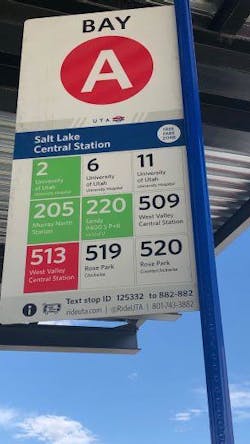UTA improving the rider experience with new bus stop signs
The Utah Transit Authority (UTA) has debuted new bus stop signs after a year-long process of working with a consultant to create the design, source the production and work with the UTA facilities team to install them.
The new signs are more intuitive, provide riders with key information and work well with UTA’s preferred trip planning app, Transit.
The sign displays the bus stop location with the blue bar across the middle, so riders know they are in the right place to catch their needed bus. After the location it tells riders the direction the bus is heading, so they know they’re on the right side of the street. The signs also feature colored squares, which tell riders the frequency and type of route. For example, route 21 is green because it runs every 15 minutes. Red means the route runs during rush hours only, and black means that it’s a seasonal route (like the ski routes). A white square indicates a regular route that runs every 30–60 minutes.
The third piece of information in the new signs are bus route numbers. In Salt Lake City, the route number tells riders what street it travels along, for example the 2, 9 and 21 run along 200 South, 900 South and 2100 South respectively. Those routes run east-west. Three-digit routes that begin with a two run north to south. For example, the 205 runs along 500 East and the 209 runs along 900 East traveling north to south.
A few other things to know about the route numbers includes:
- In Weber and Davis County, bus routes are three digits and begin with a six.
- In Utah County, bus routes are also three digits but begin with an eight.
- Most routes that run between counties are three digits and begin with a four.
The new signs still include Ride Time info so riders can text to quickly find out when the next bus is arriving. And they’re big, which increases visibility for bus operators and riders alike.
Increased accessibility and reduced costs
The pole the sign attaches to also provides information. The pole is bright blue and eight sided and are the only eight-sided poles on the Wasatch Front. This shape quickly communicates to people that are visually impaired that they are in the right spot to catch the bus.
The new sign design allows SEPTA to add a heavy-duty sticker so when a route changes, is discontinued or a new one is added, SEPTA can add a sticker, reducing maintenance costs.
More Bus Stop Improvements Coming
These bus stop signs are just the beginning of improved wayfinding for UTA. There is also the “Bay” signage on central stations like Salt Lake Central or Provo Central. These signs tell riders where to catch a specific bus at large multi-modal hubs. Next up are improved maps at these central stations and throughout the year the new bus stop signs will be making their way to more and more locations.
